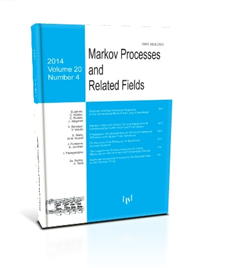Persistence of non-Markovian Processes Related to Fractional Brownian Motion
J. Krug
1998, v.4, Issue 4, 509-516
ABSTRACT
The persistence probability $P(T)$ of a stochastic process $X(t)$ is defined as the probability that $X$ does not change sign during a time interval of length $T$. Here it is pointed out that the asymptotic decay rate of $P(T)$ can be determined exactly for a one-parameter family of stationary Gaussian processes, which are related to fractional Brownian motion (fBm). The argument consists of two steps. First, the asymptotic behavior $P(T) \sim T^{-(1-H)}$ is derived for fBm with Hurst exponent $H$, a result which is argued to hold for any translationally invariant, self-affine process with stationary increments whose variance increases as $|t - t'|^{2H}$. Second, fBm is mapped onto a stationary process by going to logarithmic time. Through a comparison theorem of Slepian, our result can be used to obtain bounds on the persistence probability of more general processes.
Keywords: Gaussian processes,first passage times,level crossings,fractional Brownian motion
COMMENTS
Please log in or register to leave a comment

